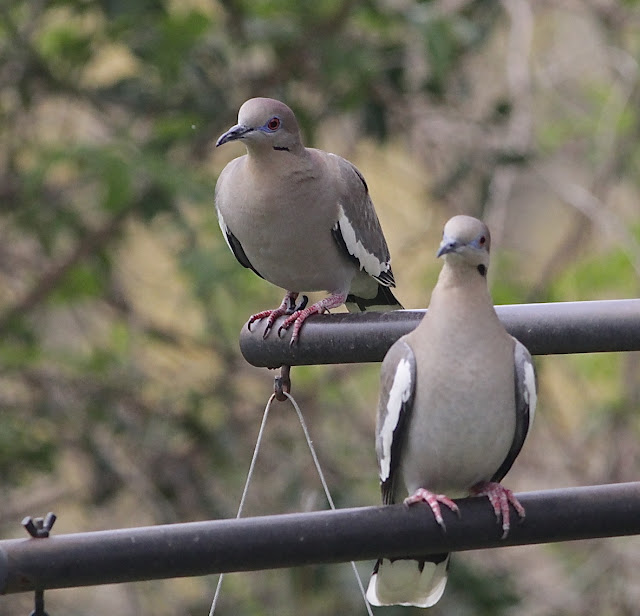This week in birds - #514
A roundup of the week's news of birds and the environment:
Just about anytime I look out a window, I'll see at least one of these guys in my yard - the ever-present White-winged Dove.*~*~*~*
The top environmental news in this country this week has been the dangerous heat wave that has affected much of the continent. It may just be a preview of our future as much of the U.S. will be part of an extreme heat belt by the 2050s. And as extreme heat becomes our norm, gardeners are looking for ways to help their gardens survive and flourish.
*~*~*~*
Europe also is enduring a scorching summer that is putting a strain on its energy systems.
*~*~*~*
The president this week signed an energy bill, one aim of which is to reduce dependence on fossil fuels.
*~*~*~*
"Forever chemicals" may soon be less than forever chemicals as scientists are making progress on a method of breaking them down.
*~*~*~*
Mexico is fighting for its share of the water from the Colorado River, water that largely gets taken by U.S. states as it travels its course. Meanwhile, the U.S. has imposed drastic cuts in water available to the states along the river.
*~*~*~*
This little beauty is the American Bird Conservancy's Bird of the Week. It is the Royal Sunangel, a bird of northern Peru and southern Ecuador.

Good morning, Dorothy. Thank you for the weekly roundup. How else would I know it is Saturday? I was really quite astounded and more than a little disappointed that not a single Republican signed onto the climate bill and you wonder what will happen to it if they regain control of the house and the senate. Do they not have children and grandchildren? When politics trumps concern for the viability of the planet you know we are in serious trouble.
ReplyDeleteI guess I will never understand what drives politics, or at least a certain brand of politics.
DeleteSo much interesting info and certainly, new to me facts in this post Dorothy. The white-winged doves are beautiful, we have the mourning doves here whose sounds drive our (2) cats crazy. The Royal Sunangel is beautiful - I've never seen a picture previously. We are even in near draught conditions here in New England, something that rarely happens, thankfully.
ReplyDeleteThe White-wings are an interesting story. They are a Central American species that has gradually expanded its range northward over the years. When we first moved here in 1988, one never encountered them but now they are the prevalent dove species year-round.
DeleteWe've finally cooled off now, and have been in the mid 80s the last few days. I can't imagine what it will be like in the 2050s. Ugh.
ReplyDeleteIt hardly bears thinking about.
DeleteI have always been interested in birds (not to the level of birding, just to learn more about them); my father used to know a lot about birds and watched the ones in his yard. Recently we have started playing a board game called Wingspan and learned a bit more about birds that way, and I am reading a book about a year of birding, Why Do Birds Suddenly Disappear? by Lev Parikian.
ReplyDeleteAnd I remember fireflies in the summer in my childhood in Alabama. I haven't seen fireflies in forever.
Ah, fireflies! I used to love chasing them around our yard when I was a child. Obviously, I was easily entertained!
DeleteI have to move north and fast! I won't survive in 125 degree weather! I will melt!
ReplyDeleteIt is too horrible to contemplate.
DeleteIt's rare that we see a White-winged Dove, but we see Mourning Doves every day.
ReplyDeleteI need to look into ways to track the Monarchs.
We have Mourning Doves, Inca Doves, Eurasian Collared-Doves, as well as White-wings, but the White-wings are the most numerous.
DeleteWhite-winged doves are absolute pests on this property, and if they had their way, they'd be the only bird species I'd ever see when I looked out a window or sat out in the garden. One of the few reasons why I can accept summer ending and autumn beginning is dove hunting season. Then the white-winged doves all disappear, and we get a well-deserved rest from them.
ReplyDeleteI've also been seeing more and more European Collared Doves. The first few years they were here, they had little tolerance of the heat. One summer, I lost count of the ECD corpses I had to dispose of. Now, many of them have interbred with the white-winged doves, and their heat tolerance has improved as a result. I'm not a fan, since they don't belong here, but at least I'm not constantly on body disposal duty!
At one point several years ago, Eurasian Collared-Doves were the dominant dove species in my yard, but they are not so numerous anymore though I still see them occasionally, especially in winter.
Delete